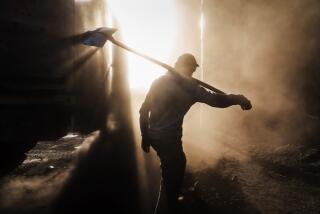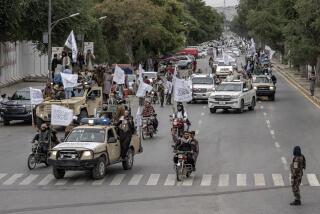U.S. Hopes for Fast Rebel Takeover : Soviet Pullout to Test Afghan Hold on Cities
- Share via
KABUL, Afghanistan — For the Soviet Union, the taste of military failure has come on this arid, inhospitable terrain in Central Asia, land of the Pushtun warrior and the Hindu Kush Mountains.
On Sunday, the Soviet army is to begin withdrawing from its unsuccessful armed intervention in Afghanistan’s bitter civil war as Moscow pulls out an estimated 115,000 troops over the next nine months.
According to Western diplomatic sources here, at least two divisions totaling 20,000 men are expected to start for home this weekend under the terms of an agreement signed April 14 in Geneva by Afghanistan, Pakistan, the United States and the Soviet Union.
Included in the massive withdrawal, Afghan government officials said Thursday night, will be several thousand troops from Jalalabad, a key city 75 miles east of Kabul, the capital, on the road that leads to Pakistan through the Khyber Pass.
That will leave Afghan army troops, along with an unknown number of Soviet military advisers, to defend one of Afghanistan’s larger cities against attacks from the U.S.-backed moujahedeen . The loosely affiliated and often feuding guerrillas, whose strength is estimated at 90,000, have battled the Soviets and the Afghan regime to a standstill in a bloody war of more than eight years.
The fight for Jalalabad is likely to be one of the first measures of how Afghan troops fare on the battlefield without Soviet forces at their side.
“Of course, the regime still has Soviet and Afghan air power,” one Western diplomat here said. “But Jalalabad will be a good test. They have never fought alone before.”
U.S. officials, who have directed more than $2 billion in covert military aid to the rebels since 1979, hope the Soviet withdrawal will lead to a quick guerrilla takeover of Kabul and the overthrow of the Soviet-backed government headed by President Najibullah, a former secret police chief who came to power in 1986.
The Soviet Union and its allies hope the Najibullah regime and its armed forces, estimated at 125,000 to 200,000 men, can hold together and allow the formation of a broad-based coalition government in which Najibullah’s People’s Democratic Party of Afghanistan survives as the major actor.
For both sides, the key is Kabul. The population of this mile-high city on the skirts of the snow-topped Hindu Kush has swollen during the war from fewer than 500,000 residents to nearly 2 million.
As the deadline for withdrawal nears, the Afghan government strategy for defending the capital is beginning to emerge, according to sources here and in Pakistan.
Beginning late in April, with the evacuation of the Soviet garrison at Barikot, on the Pakistan border about 150 miles northeast of Kabul, Soviet and Afghan troops have been pulling back from the frontier. They have been concentrating their defenses within the so-called “circular highway” that runs from the Soviet border south to Kabul, southwest from Kabul through Ghazni to Kandahar, northwest from Kandahar to Herat and north from Herat to the Soviet border.
“The pullout of the border areas is a calculated move to hold the inner circle road area and the key cities of Ghazni, Kandahar and Herat,” a senior Western diplomat here said. “Their goal is to defend the heartland.”
He added, “If one of these cities falls, then the bargaining gets serious. I think it will lead to the stepping down of the People’s Democratic Party of Afghanistan.”
The U.S. view of things to come is not shared by some other Western diplomats, notably the British, who think the Najibullah government has more support--and more staying power--than the Americans believe.
Still, most Western analysts agree that if the moujahedeen are able to capture one of the key cities, that could lead to destabilization of the Kabul government.
The moujahedeen already have begun to put pressure on the capital. Twice this month they have staged rocket attacks that, for the first time in several years, managed to hit the Wazir Akbar Khan district, where many government offices, diplomatic missions and Soviet-built housing projects are situated.
On Monday, the government said that at least 12 rockets hit Kabul. Officials said the attack was mounted from moujahedeen positions in the hills south of the city. Government officials said 23 people were killed and 28 were injured in the attack, which one called the worst Kabul has known.
The rockets were said to have terrorized usually tranquil areas of Kabul. One rocket, described as a Chinese-made 122-millimeter device, landed in the Soviet-built housing area known as Micro Rayon. It barely missed an elementary school and exploded in a field, killing five people, four of them children. Soviet and East European families live in the project, but none were reported injured.
Reporters visiting the site Thursday saw several Soviet civilians wearing handguns in holsters strapped around their waists.
Another rocket hit in the residential area known as Ayub Khan Mena, south of the city, reportedly killing seven people in an Afghan family of nine. The survivors were a 6-month-old girl and a boy of 8, who had been playing soccer in a field nearby.
“When I heard the explosion,” the boy said Thursday, “I began walking home. A boy told me the rocket had come down on my house. I ran. I saw my sister without her head. I saw the leg of my mother one place, and the other leg was another place.”
On Thursday afternoon, several hundred schoolchildren, in a demonstration sponsored by the People’s Democratic Party, stood and chanted outside the U.S. Embassy, protesting the rocket attacks.
“Death to the USA,” the grade schoolers chanted. “Death to the CIA.”
More to Read
Sign up for Essential California
The most important California stories and recommendations in your inbox every morning.
You may occasionally receive promotional content from the Los Angeles Times.













